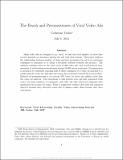The Reach and Persuasiveness of Viral Video Ads
Author(s)
Tucker, Catherine Elizabeth
DownloadTucker_The reach.pdf (809.4Kb)
OPEN_ACCESS_POLICY
Open Access Policy
Creative Commons Attribution-Noncommercial-Share Alike
Terms of use
Metadata
Show full item recordAbstract
Many video ads are designed to go viral so that the total number of views they receive depends on customers sharing the ads with their friends. This paper explores the relationship between the number of views and how persuasive the ad is at convincing consumers to purchase or to adopt a favorable attitude towards the product. The analysis combines data on the total views of 400 video ads, and crowd-sourced measurement of advertising persuasiveness among 24,000 survey responses. Persuasiveness is measured by randomly exposing half of these consumers to a video ad and half to a similar placebo video ad, and then surveying their attitudes towards the focal product. Relative ad persuasiveness is on average 10% lower for every one million views that the video ad achieves. The exceptions to this pattern were ads that generated views and large numbers of comments, and video ads that attracted comments that mentioned the product by name. Evidence suggests that such ads remained effective because they attracted views due to humor rather than because they were outrageous.
Date issued
2014-10Department
Sloan School of ManagementJournal
Marketing Science
Publisher
Institute for Operations Research and the Management Sciences (INFORMS)
Citation
Tucker, Catherine E. “The Reach and Persuasiveness of Viral Video Ads.” Marketing Science 34, no. 2 (March 2015): 281–296.
Version: Author's final manuscript
ISSN
0732-2399
1526-548X